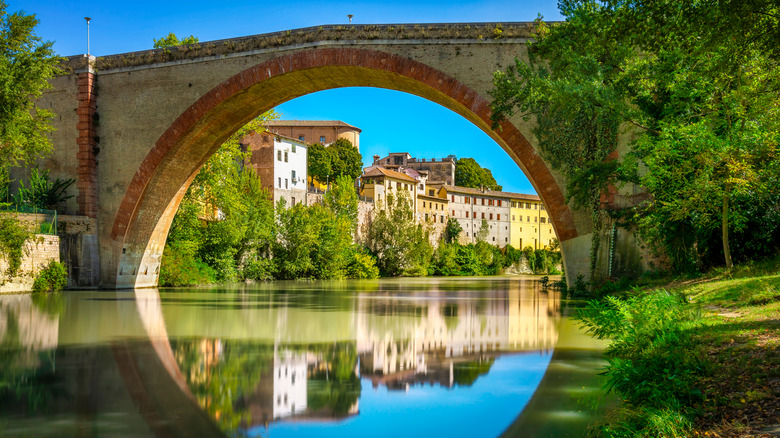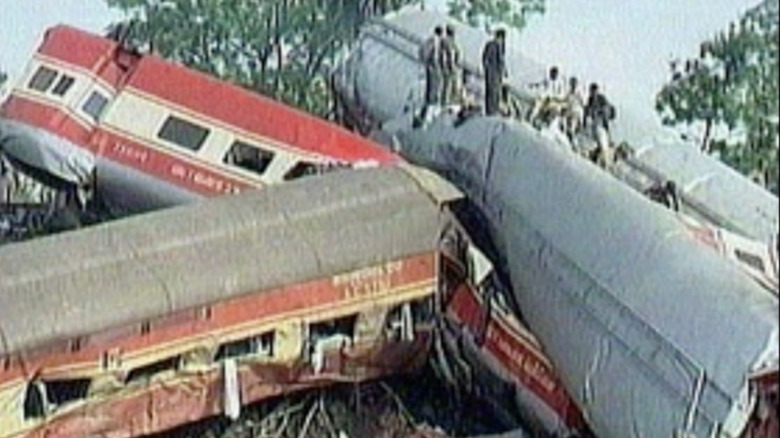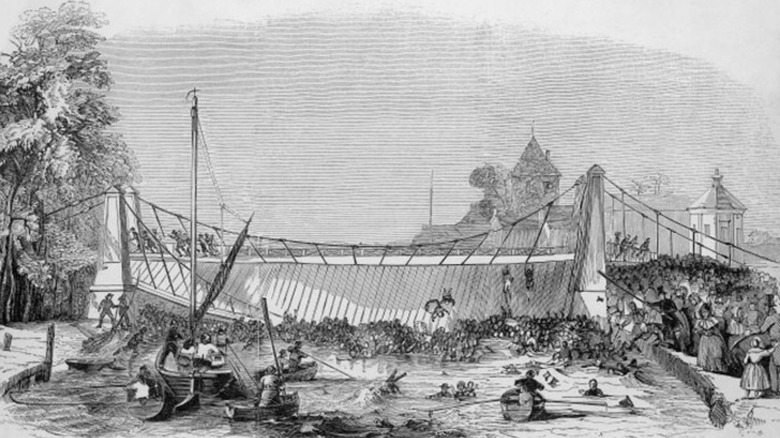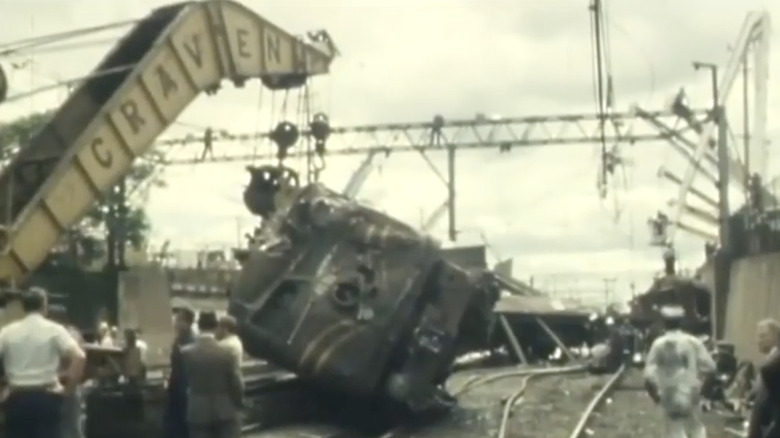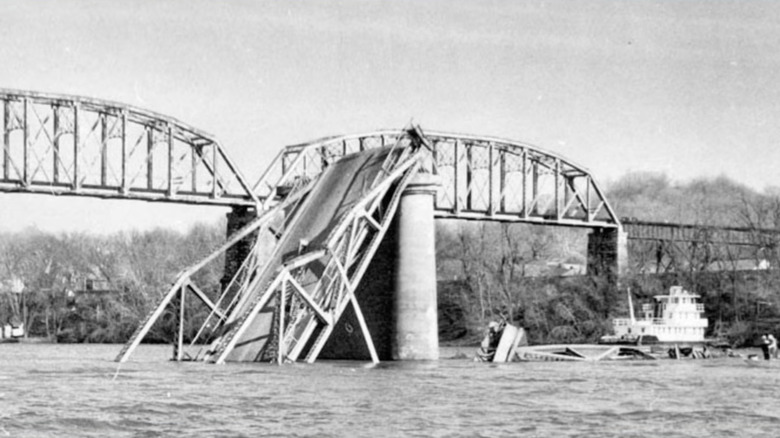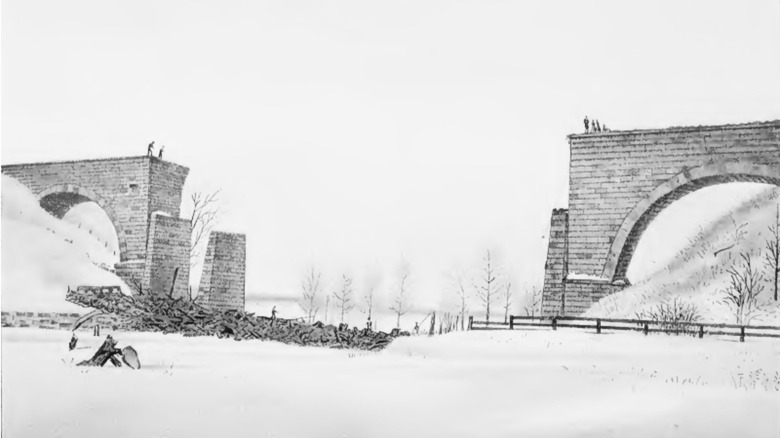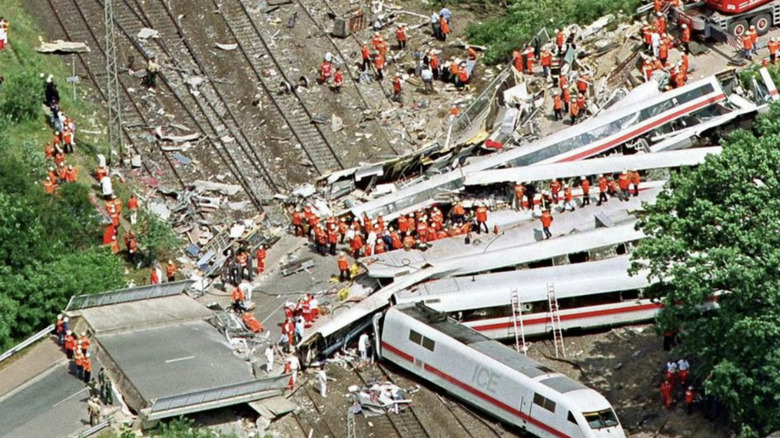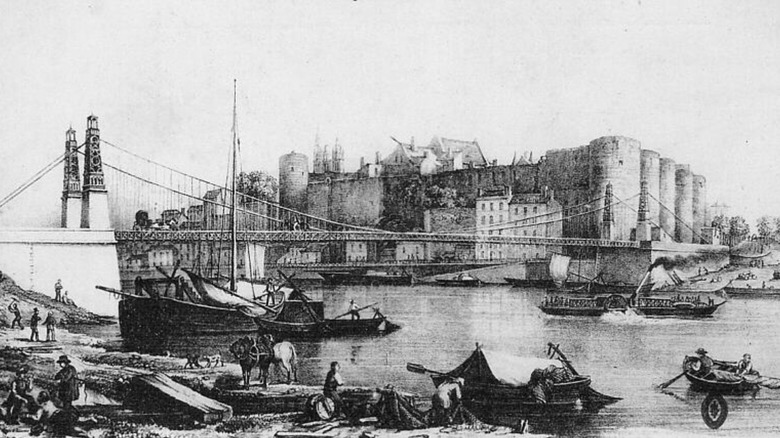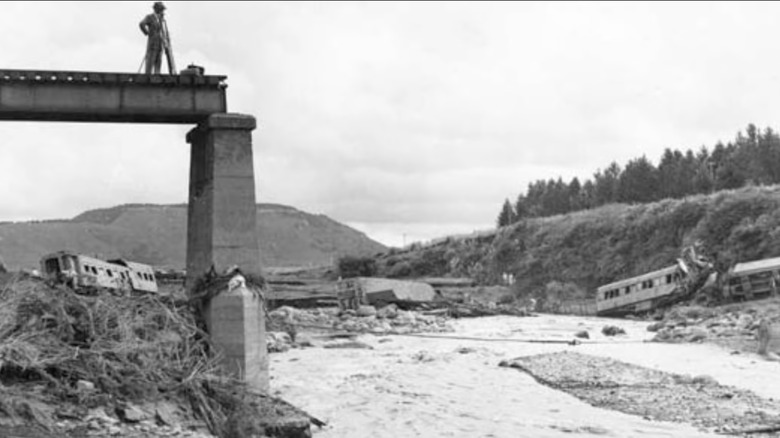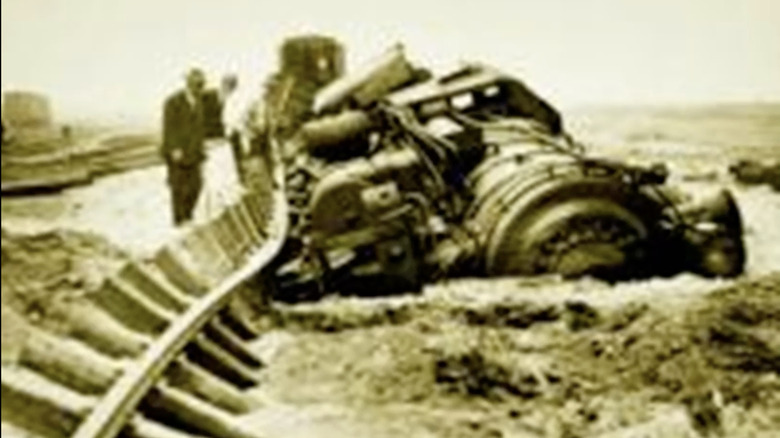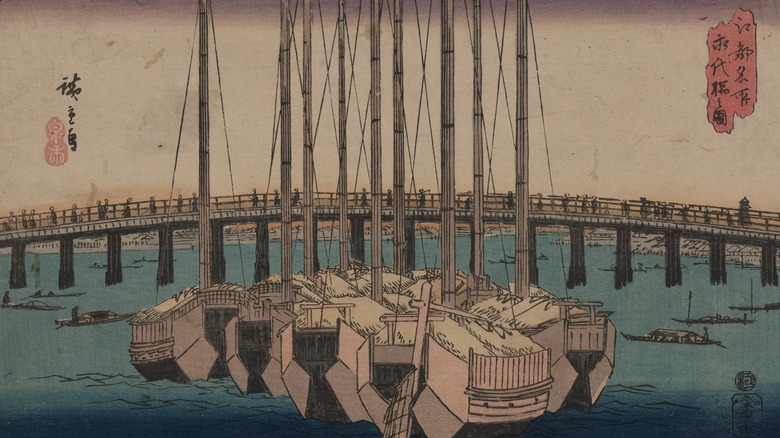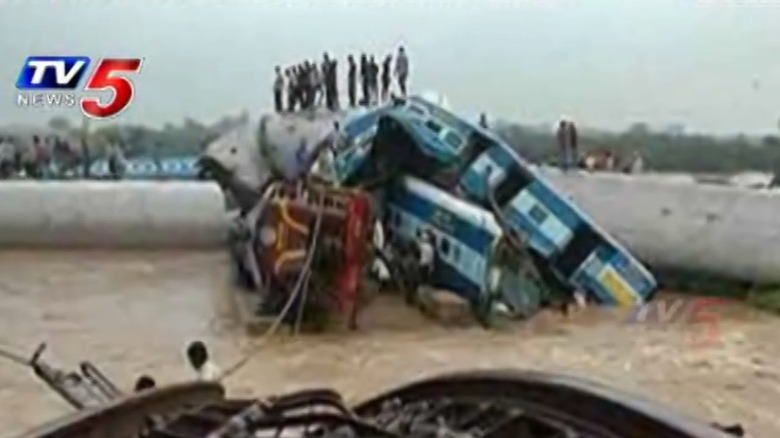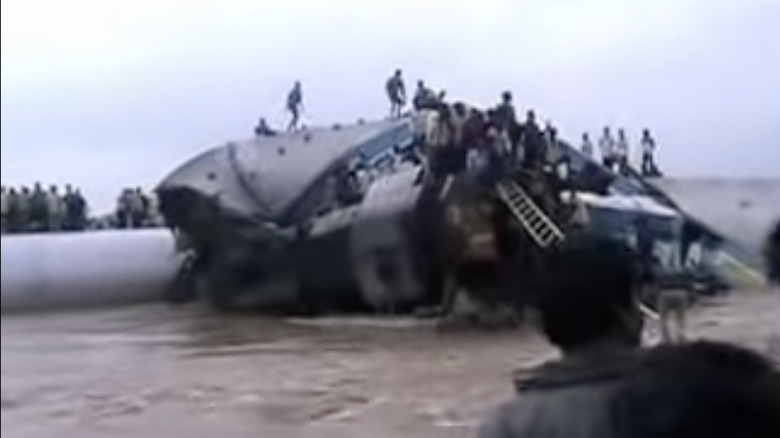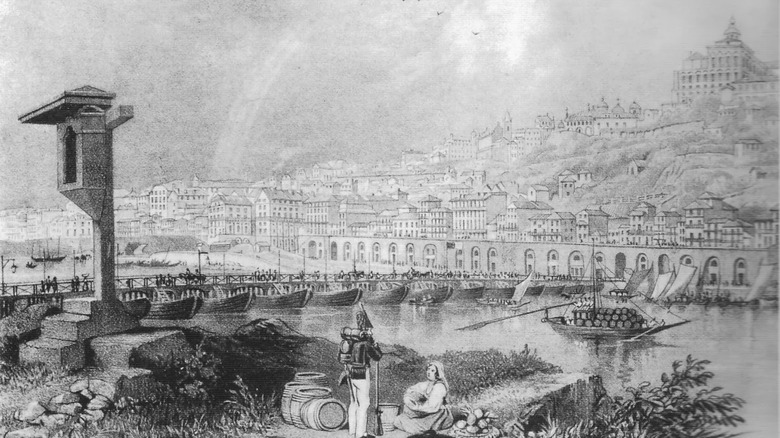The Deadliest Bridge Disasters In History
Since time immemorial, humans have constructed bridges to access rugged terrain, reach water-locked peninsulas, and cross raging rivers. From rough-hewn rope and wood suspension bridges to finely carved stone ones, constructing bridges has evolved over the millennia. During the Roman Empire, bridge construction reached new heights (literally) as engineers relied on mortar crafted using ground volcanic rocks, per Science. And during the Industrial Revolution of the 18th and 19th centuries, massive leaps in bridge design occurred, accommodating new technologies like locomotives (via OpenLearn).
But while these human-made marvels represent impressive construction feats, bridges also come with an element of danger. Some people struggle with a legitimate "fear of bridges," known as gephyrophobia (via Medicine Net). For this slice of the population, gephyrophobia translates into white-knuckling it across bridges or hiring others to drive them. Some individuals refuse to travel bridges at all. While this significantly limits where they go and what they see, after learning about the deadliest bridge disasters in history, you might gain a new appreciation for gephyrophobia. After all, when things go wrong on bridges, they often become catastrophic in mere seconds.
From railway bridges collapsing mid-train crossing to pedestrian suspension bridges that have thrown hundreds or even thousands of people to watery deaths, here are 13 events that'll put the fear of bridges in you.
India's Rafiganj Rail Bridge tragedy
Every day, Indian Railways achieves incredible feats. They transport more than 13 million people via 14,000 trains, per The Guardian. While an incredible achievement in terms of public transportation, things don't always run smoothly. For example, on September 9, 2002, five cars of a luxury passenger line plunged off a bridge into the Dhave River below.
The accident happened near the town of Rafiganj, approximately 130 miles (210 km) from the capital of Bihar, Patna (via The Tribune India). Railway officials immediately raised the terrorist alarm, blaming Maoist groups operating out of the Bihar area. But local law enforcement demanded a more nuanced examination, including a review of recent maintenance related to the 66-year-old bridge. While some wanted to blame the tragedy on Indian Railways, investigators soon discovered a troubling reality.
Indeed, the train's tracks had been tampered with. According to Telegraph India, fishplates, "the steel bars that join the ends of a rail," had been removed, leading to one of India's worst train accidents in history. Approximately 30 days after the horrific crash, a Bihar-based group known as the Maoist Communist Center claimed responsibility for the impact. All told, more than 130 passengers on the luxury high-speed train plunged to their deaths. Some say the figure could be much higher, with upwards of 50 additional people unaccounted for after the crash.
England's Yarmouth Bridge collapse
Onlookers lined the Yarmouth suspension bridge on May 2, 1845 (via the BBC). They came to watch the merry antics of a clown named Arthur May Nelson, per The Clown King. To promote Cooke's Royal Circus, the clown announced a whimsical performance. He would embark on a watery journey along the River Bure in a washtub drawn by four geese. Nelson had adapted the trick from Dicky Usher, performing it across the nation as a signature stunt.
But the so-called "Clown King" and the thousands who collected to watch him could've never imagined the tragedy about to unfold. Overwhelmed by the large number of spectators that traveled far and wide for the event, the Yarmouth bridge collapsed beneath their weight. According to the BBC, the bridge failure contributed to the "largest recorded loss of life in one single incident in Great Yarmouth's history." How did it happen? As Nelson passed under the bridge, the crowd rushed to the opposite side to catch sight of him.
According to the Great Yarmouth Mercury, the sudden weight shift caused one of the suspension bridge's metal links to fail, tossing 400 people into the river. Of the hundreds that entered the frigid waters, 79 (primarily women and children) drowned, as reported by the BBC. Julie Staff, who raised funds for a memorial, said of the heart-wrenching tragedy: "One minute everybody would be excited to see the clown. It would then have turned into a scene from hell."
Australia's Granville Railway Bridge disaster
The worst bridge accident in the "Land Down Under" occurred on January 18, 1977, when an electric locomotive derailed (via the BBC). It slammed into the Bold Street Bridge's supports, creating a chain effect of events. Four cars sat atop the bridge at the time, and they rained 518 tons of steel and concrete down on the railcars below. In the end, a total of 83 people died and another 213 were wounded.
What makes this event so tragic? Besides the terrible loss of life exacted that day, the event proved utterly preventable. As reported by the BBC, "Australia's worst rail disaster took only seconds to happen but was a decade or more in the making." Inspections after the incident revealed significant problems with railway infrastructure (via ABC). Employees should have caught these problems in the weeks leading up to the accident. But a revolving door of new track inspection employees meant countless unreported and overlooked issues.
The accident also revealed serious issues with Granville's first response system. Spectators flocked to the scene, forcing rescue workers to play crowd control. Searing temperatures combined with lack of organization and preparedness contributed to high death counts. Topping it all off, too many medical workers clamored to the scene. At one point, "up to 30 people were observed trying to carry single stretchers," per the BBC. Instead, experts agree that first responders should've headed to nearby hospitals to prepare for the influx of critically injured passengers.
USSR's Ulyanovsk Railway Bridge collision
The "Aleksandr Suvorov" set sail from Rostov for Moscow on June 5, 1983, with an estimated 330 passengers, 30 crew members, and 35 service personnel onboard, according to Asket. Some experts suspect the cruise ship contained unregistered passengers, too, making an accurate count impossible. By 10:45 pm that night, an auction took place on the upper deck, drawing a large crowd. The ship's captain, Vladimir Kleymenov, had retired to his cabin for a little R&R, and helmsman Uvarov and chief mate Vladimir Mitenkov steered the cruise ship.
When it reached the Ulyanovsk Railway Bridge spanning the Volga River, what should have been a routine passage beneath the underpass turned into a nightmare. From the bank, controllers quickly realized the ship sailed towards the wrong span of the bridge. At the same time, a freight train clambered over the bridge. Despite frantic messages to the vessel and the launch of an emergency flare, controllers watched in horror as the "Aleksandr Suvorov" sailed at top speed into the bridge.
An epic collision tore through the cinema hall and the deckhouse where passengers had gathered. Making matters worse, the freight train above toppled off the bridge and onto the ship, per UPI. The accident resulted in 177 deaths. Fortunately, the ship remained afloat, protecting its remaining passengers and crew until rescue boats arrived 40 minutes later.
Ohio's Ashtabula River Railroad Bridge nightmare
The Pacific Express No. 5, a Lake Shore & Michigan Southern Railway train, chugged through a blizzard onto the Ashtabula River Railroad Bridge in Ohio on December 29, 1876 (via PBWorks). Winds gusted at 40 miles per hour, and two feet of snow lay on the bridge's tracks. Built between 1863 and 1865, the railway bridge was nearly a dozen years old when the unthinkable happened — total failure.
After the train's first locomotive, the "Socrates," cleared the bridge, the conductor looked back, watching the rest of the train disappear. He immediately sounded the alarm. A total of 159 passengers and railroad crew members on a second locomotive and 11 railcars plummeted into the 70-foot-deep gorge below, as reported by Roadside America. The Ashtabula River, which measures a shallow three to four feet deep, provided no cushion.
On the descent, railcars collided mid-air and smashed those they landed atop into oblivion. For survivors of the fall, more danger lay ahead. The oil lamps and coal stoves warming the train's passenger cars caught fire, incinerating many passengers. To top it off, robbers arrived, picking through the burning wreckage, and murdering more passengers. A perfect storm of calamity, it resulted in 98 dead and 64 injured, with nearly 50 of the bodies unidentifiable, per PBWorks. Today, a humble historical marker commemorates the tragedy, declaring it "one of the world's ten worst technology disasters in the past 375 years."
Germany's Eschede Road Bridge catastrophe
Germany's worst train disaster created a bridge catastrophe in 1998, as reported by Medium. The high-speed Intercity Express (ICE) train traveling as "Wilhelm Conrad Rontgen" derailed at 124 miles per hour (200 kph), obliterating two columns of the bridge it passed under in Eschede. According to the National Library of Medicine, "the force of the collision, combined with the speed of the train's rear-engine, propelled the rear wagons into the structure."
Destruction of the bridge's columns triggered a hail of 300-metric tons of concrete down onto the passing railcars, especially cars five and six. Between the force of the collision and the debris, the dining car (car six) was smashed to an unbelievable height of just 5.9 inches (150 mm). The rest of the railcars plunged "into the growing wreckage one by one, in a process likened to a folding ruler," per author Max Schroeder. The force compressed eight ICE cars to the length of a single car (87 feet) in a matter of seconds, killing the majority of the passengers instantly.
What caused the nightmarish crash? A tire from the forward axle of the first car broke, possibly due to unnoticed stress fractures. After snapping, metal from the tire crashed through the railcar, narrowly missing two passengers. Instead of triggering the train's emergency stop, the conductor ordered a mandatory evaluation of the damage, sealing the train's fate. All told, the crash resulted in 101 deaths. Fortunately, the ICE 787 "Karl Adam" ran two minutes early that day. Otherwise, it would've crashed into the debris moments later.
France's Pont de la Basse-Chaîne collapse
Although it's hard to surpass the devastation and carnage wrought by railway disasters, one of France's worst bridge collapses involved pedestrians, as reported by World History Project. It took place on the Pont de la Basse-Chaîne (the Angers Bridge) on April 16, 1850. Workers constructed the suspension bridge spanning the Maine River between 1836 and 1839, and it stood for a dozen years before its demise.
According to historical accounts assembled by the Bridges of Dublin, the Angers Bridge saw heavy use that morning because of nearby military activity. A hussar squadron had just cleared it when a second group of 500 French soldiers, the 11th Light Infantry, approached. In charge of that day's activities, Colonel Simonet yelled a warning to the battalion, ordering them to spread out and march in silence. Unfortunately, an approaching thunderstorm drowned out his words, and the 11th started across in full formation, their band playing.
As the battalion marched in perfect rhythm, passers-by heard a terrible crash. A cable broke, sending a cast iron column into battalion members still waiting to march across. But those already on the Angers didn't escape the disaster. After the column fell, the bridge's walkway followed, throwing four civilians and 483 soldiers into the river. Two-hundred and twenty people perished. A later inquiry found that the combination of the storm, the resonance of the soldiers' marching feet, and the bridge's rusted cables all contributed to the disaster.
New Zealand's Whangaehu River Rail Bridge disaster
On Christmas Eve 1953, New Zealand experienced its worst bridge disaster in history when a train plunged into Tangiwai's Whangaehu River in the central North Island, per Environment and Society. While New Zealand's railway workers had significant experience dealing with flooding, they had far less when it came to lahars.
What are lahars? Fast-flowing and devastating mudflows that sprout from volcanoes. According to the USGS, "a moving lahar looks like a roiling slurry of wet concrete, and as it rushes downstream, the size, speed, and amount of material carried can constantly change." Although volcanic explosions may trigger lahars, they also happen for other reasons. The lahar in New Zealand resulted from the collapse of a natural tephra dam. The dam had formed after an eruption of Mount Ruapehu in 1945. It held back a crater lake until the lake swelled to such a volume, it erupted into a lahar, spewing 70,629,333 cubic feet (2,000,000 cubic meters) of water (via Stuff).
Unfortunately, the train reached the bridge at the same time as the lahar's sulfuric waters. Although a local motorist warned the train's crew by holding a light, the warning came too late. The heroic crew gave it their all, but the locomotive couldn't stop in time. It bore 285 passengers, and 151 perished as the railcars plunged into the frigid glacier-fed river below.
Colorado's Dry Creek Bridge calamity
When it comes to the deadliest bridge disasters in the United States, the Eden train wreck ranks at the top, as reported by History and Headlines. The calamity occurred when a flash flood washed out the Dry Creek Railway Bridge near Pueblo, Colorado. The typically dry arroyo turned into a dangerous churning channel of water in a heartbeat. Unfortunately, the Denver & Rio Grande Railroad's Express No. 11 crossed the bridge just as the lahar washed it out.
The front part of the train got washed away with the bridge, and later recovery efforts located the locomotive in the mud near the bridge. Another railcar known as the "chair car" ended up about a mile down the washout. Four miles downstream, a smoking car and baggage car turned up. Rescue workers even found one victim 22 miles away from the scene of the disaster. According to archives from Pueblo, "The train was cut in two. The two Pullman cars and dining car remained on the track, the coupling having given way as the smoking car plunged into the abyss, leaving the end of the nearest Pullman hanging four feet over the abyss."
Fortunately, the locomotive's conductor had slowed the train to 15 mph due to weather and washout warnings, which kept the death toll from rising even higher. What's more, brakemen in the Pullman cars prevented more of the train from washing away. Nevertheless, 111 people perished in the accident. But within 24 hours, workers had patched the damaged railway bridge, and it transported trains once more, per Waymarking.
Japan's Eitai Bridge disaster
Once upon a time, the graceful lines of the wooden Eitai Bridge permitted pedestrians to cross the Sumida River that cuts through Tokyo. Built in 1698, the elegant minimalism of the structure inspired Utagawa Hiroshige, a famed Japanese artist, to create a series of woodblock prints celebrating its esthetic simplicity, as reported by Go Tokyo.
Locals built a Buddhist temple on Eitai Island in 1624, per Japan This. Known as Eitai Temple, it came to hold a major shrine in 1627, the Tomioka Hachiman-gu. But those living in Tokyo could only access the temple and shrine via ferries known as watashi. Everything changed with the construction of the Eitai Bridge, a large and accommodating byway offering exceptional views. As Hiroshige's woodblocks depict, the Eitai Bridge functioned as a busy pedestrian route, connecting commercial Tokyo with Eitai Island.
But like most bridges, there was a problem: Who would handle the upkeep? Villagers on both sides of the bridge disagreed, and the stunning bridge fell into disrepair. Slow decay turned into calamity in 1807 when thousands of people piled onto the bridge during a festival. Unable to bear the weight of the revelers, a section of the bridge collapsed, sending an estimated 1,400 people to their deaths, drowning in the Sumida River below, per Bridge Masters.
India's Valigonda Railway Bridge Devastation
In October 2005, a train in southern India plunged off the Valigonde Railway Bridge into the rain-swollen river below, as the Los Angeles Times reported. What caused the derailment? The train hit a portion of track washed out by flash floods. This caused seven railcars to fall from the bridge, contributing to the deaths of 114 passengers.
Railcars piled atop one another, either partially or fully submerged in the river. Rescuing trapped people from the wreckage proved daunting. Helicopters lowered soldiers onto the seven derailed cars. First responders recovered individuals hanging from ceiling fans, luggage racks, and just about anything else they could grab onto to keep from drowning (via the BBC).
According to passengers, the derailment occurred in the middle of the night. Some remember awakening to shrill screams and a sense of falling. According to P. Ramesh, "We were fast asleep, when there was a big band and a thud. The next thing, the train was under water." While some passengers managed to escape the railcars and swim to safety, others got trapped inside, making rescue efforts a race against time. Unfortunately, regional flooding also washed-out roadways, making it difficult for ambulances to reach the scene of the tragedy.
England's Harrow and Wealdstone Station Footbridge debacle
On a foggy morning in 1952, the unthinkable and improbable took place in the northwest London Borough of Harrow. According to the Londonist, the Tring train from Perth to Euston missed the Harrow and Wealdstone station's signals, slamming into a parked train at 8:18 am.
The Tring carried roughly 800 passengers, and the last three railcars slammed so rapidly into one another that they telescoped, killing the passengers instantly. But the tragedy didn't stop there.
Moments later, a third express train appeared, traveling from Euston to Liverpool. Because of the fog, the new train couldn't see what lay ahead, plunging into the two demolished trains at 60 miles per hour. The force of the speed catapulted railcars into the air and onto a nearby footbridge, and the two locomotives propelled themselves up onto a platform. All told, the cataclysm resulted in 112 deaths and more than 300 injured. Today, it remains "the most catastrophic train crash to happen during peace time in England," as reported by MyLondon.
Portugal's Ponte das Barcas nightmare
Inaugurated on August 15, 1806, the Ponte das Barcas ("Bridge of Boats") marked the first permanent bridge to span the Douro River in Lisbon, per Disasterthon. Constructed using 20 ships anchored next to one another, the unique structure permitted the bridge to be disassembled and reassembled easily and efficiently. Famed Portuguese architect and engineer, Carlos Amarante, designed it to carry the weight of small crowds of passers-by. He could never have envisioned the nightmare to come (via Porto Tours).
During the Napoleonic Wars, French forces under the leadership of Marshal Soult invaded Lisbon in 1807. Fleeing a bayonet charge, thousands of Lisbon residents flocked onto the bridge in a mad dash for survival. Following them onto the bridge were fierce legionnaires bent on further terrorizing the citizenry. Amarante had not designed his bridge to hold so much weight. As the overburdened boats plunged beneath the waters of the river, people panicked.
In the great tumult produced by the advancing soldiers and fleeing Portuguese, roughly 4,000 people perished. But getting an accurate count remains difficult. Some historians theorize casualty numbers may have gone much higher, approaching upwards of 6,000 casualties. Following the disaster, locals rebuilt the bridge but only temporarily. Another floating bridge wouldn't permanently occupy the site until 1843. Today citizens of Porto keep the memory of those lost in the bridge disaster alive by continuing to light candles and leave flowers at the remembrance shrine for the Ponte das Barcas, located near the Alminhas Bridge (via Traces of War).
